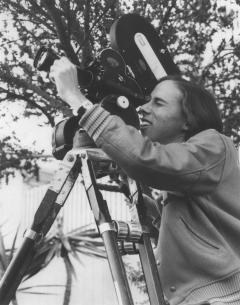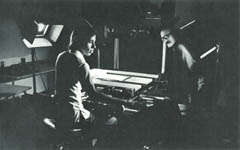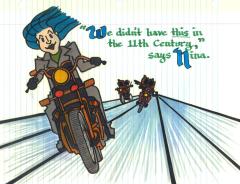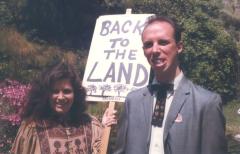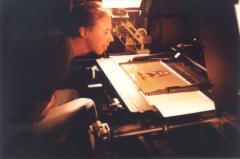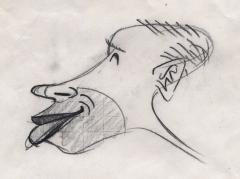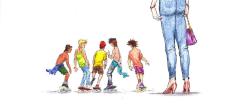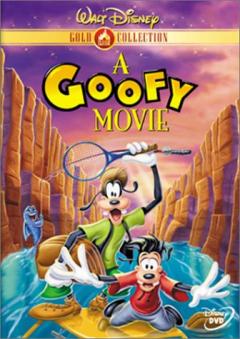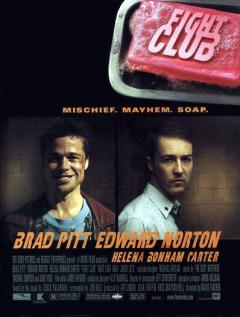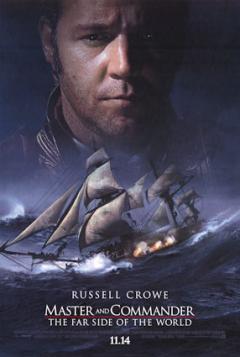David Koenigsberg
|
|
David Koenigsberg is the director, producer, production executive and overseas supervisor of motion pictures and television series, who has gone back and forth between animation and live action.
As a child he was a self-taught animator and visited all the local studios. In late 1967 he received a special audio recording from Paul Frees encouraging him to continue. (Koenigsberg was friends with Ed Newman, whose father, Robert Newman, ran the recording studio NewJack Recorders, where Frees liked to record. Ed Newman would later be one of the co-founders of Calabash Animation in Chicago.)
David attended Los Angeles City College (LACC) Radio, TV & Film department (where one of his classmates was Ed Newman)! Koenigsberg won the "Outstanding Cinema Department Student" award for the Spring of 1974 and made the Dean's Honor List a year later in the Spring of 1975. While there he made two short 16mm films.
Grand Motel (1974) was a 3 1/2 minute parody of Grand Hotel (1932). The short was actually a lighting assignment project in a cinematography course. Since the assignment included sync sound David turned it into a film. Shot in one (long) night, in a single hotel room (in what was the Holiday Inn in Hollywood), the film is a marvel of economy. Crew members included Victor duBois, Dran Hamilton and Osvaldo Zornizer. In front of the camera, among others, was Tani Guthrie.
A Very Good Year (1975) was a 6 minute film about a little girl who shoots down a blimp with a pea shooter. Production included many long hours filming the Goodyear airship Columbia based in Carson, California. The director became very familiar with the take-off and landing patterns of the blimp and could position his camera to get any angle needed. It was very much akin to shooting predictable wildlife footage.
Storyboarded and edited to selections from Richard Wagner's "The Rings of Nibelungen," the film is a homage to Leni Reifenstahl's Olympia (1938). The short won a Cine Eagle Award in 1975, was entered into the Library of Congress and was subsequently screened around the world at various film festivals.
Koenigsberg was then accepted into the California Institute of the Arts (Cal Arts), during which he produced a mock commercial (4X Film), was nominated for an Eddie Award (from the American Cinema Editors), received an Irvine Foundation Scholarship for 1976 and that same year was made a member of the Short Film selection committee for Filmex (the Los Angeles film festival).
While attending Cal Arts, David worked on stage presentations, edited student films and was director of photography on some shorts.
He then found work in Film Preparation for Filmex which lead to a gig as Head Projectionist at the New Beverly Cinema (later purchased by Quentin Tarantino) and other theaters in Los Angeles.
During this same time he directed a 35mm short, Her Continuing Temptation which starred Anne Terrail and Aimee Eccles with director of photography Victor duBois. Although it has music and sound effects, the film is basically a modern silent about a woman who thinks she might be a lesbian.
His experience at the New Beverly Cinema led to becoming the Special Programs Coordinator for Filmex. From 1979 through 1983 Koenigsberg worked with all of the major studios, domestic & foreign distributors, archives and filmmakers to create and/or supervise all of the special programs at the film festival. He personally programmed three 50 hour marathons (often used to present individual shorts & features not usually available).
Starting at this same time, David had been raising money to start a special effects/animation camera service company. He found 3 partners. 1 was an alumnus from LACC, Osvaldo Zornizer, and 2 were alumni from Cal Arts, Mark Kirkland and Richard Jefferies. On July 14, 1979, their company, New Hollywood, Inc., opened for business with a day and night party. Actually, even before opening they already had their first client.
Koenigsberg ran the company for almost 13 years from the opening in 1979 through early 1992. For the company he produced & directed the promotional short, This Is CinemaScope (1987) extolling the great virtues and ease of shooting in that process. The 35mm film was only 2 minutes long and was projected at one frame per second through a Todd-AO anamorphic lens on the animation camera stand owned by New Hollywood. Presented for only one night at the company's 1987 anniversary party, the film was wildly successful and had a huge impact on the animation community. You can listen to it here!
For New Hollywood, David used all of his contacts from LACC, Cal Arts and Filmex to amass an amazing list of clients. What follows is only a partial list of the productions the company worked on from 1979 to 1988 (you may wish to scroll ahead).
One particular client deserves a special mention. Armand Hammer, president of Occidental Petroleum, bought the Leicester Codex notebooks of Leonardo da Vinci at an auction and wanted to make a film about the contents. New Hollywood was contacted to photograph the drawings that da Vinci had animated in 1508.
Koenigsberg noted, "That was one of the weirdest nights in my life. Making sure to position and manipulate prints of the drawings so that they would animate properly. I felt that the animator, da Vinci, was watching my every move, concerned that I wouldn't get something right. I wanted to tell him that next time, not to to wait so long to get his work to camera!" The notebook is now owned by Bill Gates.
New Hollywood, Inc.
Produced and/or Photographed hundreds of Live Action and Animated:
Short Films
Including films directed by Jon Borofsky, Exene Cervenka, Georganne Deen, Red Grooms, Mary Lambert, Henry Selick.
Educational Films
Including films for Disney & Filmfair.
Interactives
Including the Los Angeles County Museum of Science and Industry, Southern California Edison.
Documentaries
Including "Autism" for the UCLA Psychology Department; "Broken Rainbow" (Oscar); "The J.P.L. Story"; "The Making of: The Grand Canyon, The Hidden Secrets"; "In The Name Of The People" for PBS; "Ernie Andrews: Blues for Central Avenue" for Lois Shelton and Ron Shelton.
Industrials
Including Apple Computers, CBS, Exxon, Fluor Engineers, Hughes Aircraft, IBM, Lockheed, Mazda, Panasonic, Rocketdyne, Warner/Electra/Asylum, Xerox.
Music Videos
Including George Clinton, Danny Elfman, The Manhattan Transfer, Ozzy Osbourne, Stan Ridgeway, Paul Simon, The Specials, The Talking Heads, The Tom Tom Club, The Untouchables, Suzanne Vega.
Logos
Including Abbott Power, Arrow Shirts, Calaway Park (Canada), Conoco, Group W Broadcasting, Hoover Vacuum, KTTV, The Barbara Mandrell Show, Music Plus, Network Ten (Australia), Pacific Telephone, Pioneer Chicken, The Playboy Channel, The San Diego Padres, Sea World.
Logos/Commercials/(TV) Shows for Broadcasters
Including:
|
KBOY KFMB KIEE KIXI KNOB KROI KROY KSSN KUUT KZZB WBEN WBLK WDUR WIXX WJZ WLUM WMET WNEV WPEG WRMZ WMOC |
KCTS KHIT KITT KLOS KOCE KROQ KSOP KTTV KXTZ WAQZ KBKR WCCC WHWK WJYO WKEZ WLYT WNET WOWE WQLT WTOP WYST |
Commercials
Consumer
Including Baltimore Six Flags, Barker Bros., Blondie, Blue Bonnet Margarine, Carta Blanca Beer, Chuckwagon, Denny's Restaurants, Diet Pepsi, Farah Slacks, Ford Elite, Gemco, General Electric Halogen Bulbs, Glad Bags, Hunter Fans, Jovan, Lux Soap, Mattel, Memorex, Mr. Coffee, Mr. Goodwrench, Nissan, Ocean Spray, Philips (Electronics), Pillsbury, Pioneer (Electronics), The Queen Mary Tour, Radio Shack, Rubik's Cube, Sanyo, Shell No Pest Strip, Sugar Crisp, Winston Cigarettes (Mexico).
Financial
Including American Federal, American Home Savings, Cleveland Trust, First National Bank, Honolulu Federal, Toledo Trust.
Corporate Positioning
Including AT&T, Blue Cross/Blue Shield, Chevrolet, Chrysler, Exxon, Goodyear, IBM, Southwestern Bell, Standard Oil, TRW, The United Way, Westinghouse.
Music Videos
Including Blondie, Gene Loves Jezebel, Amy Grant, Janet Jackson, Joe Jackson, The Little River Band, The Steve Miller Band, Pretty In Pink (Soundtrack), Supertramp, Van Halen.
Trailers
Including "Eleni", "Indiana Jones and The Temple Of Doom."
Commercials
Television Pilots, Episodes, Series & Specials
Including "The AFI Life Achievement Awards", "Amazing Stories", "Candid Camera", "The Electric Company", "In Search Of...", "International Animation" (Main Title only for PBS), a spec project with Kirk R. Thatcher, "The New Monkees", "9 To 5", "On The Record", "Ren & Stimpy", "Saturday Night Live", "Sesame Street", "The Simpsons", "Soul Train", "The Wonderful World of Disney."
Theatrical Commercials
Including El Pollo Loco, Hagkaup Department Stores (Iceland), Landmark Theatres Discount Card.
Theatrical Shorts
Including "Disney On Film" - John Lassetter, "The Housekeeper" - Brett Thompson, Doug Walker & Ian Gooding, "Jac Mac and Rad Boy Go" - Wes Archer, "Ren & Stimpy in Big House Blues" - John Kricfalusi, "Vincent" - Tim Burton.
Theatrical Trailers
Including "The Best Little Whorehouse In Texas", "Butterfly", "Return Engagement", "Second Hand Hearts", "Six Weeks", "Trail Of The Pink Panther."
Motion Pictures
Including "Better Off Dead", "Cheech & Chong's Next Movie", "Children Of The Corn", "The Chipmunk Adventure", "Dead Kids" (Australia), "Dinosaurs", "Earth Girls Are Easy", "Friday the 13th: Part 3D", "Handgun", "Harry and The Hendersons", "Hedda Gabler" (Subtitles), "The Howling", "Jaws 3-D", "The Man Who Wasn't There" (3D), "Mugsy's Girls", "Mutant" (3D), "Not Since Casanova", "One Crazy Summer", "One From the Heart", "Orin: The Legend Of Starchaser in 3-D", "Pee Wee's Big Adventure", "Phoenix", "Something Wicked This Way Comes", "Star Trek: The Motion Picture", "Summer Spell", "Tapeheads", "The Thing" (1982), "True Stories", "The Wizard Of Speed and Time."
David worked on some jobs as an individual in order to accommodate certain clients. Two such assignments concerned Tim Burton.
As a favor to Tim and Rick Heinrichs, Koenigsberg provided the voice of a Gingerbread Man (who wants to be eaten) in the short, Hansel and Gretel (1982). The part was actually recorded on the live action set, scaring the child actors to no end.
The other was the Steven Spielberg Amblin'/Universal television series Amazing Stories. An anthology series, one episode was the animated, "Family Dog," (1985) which was created by Burton.
"Family Dog" was originally part of a presentation of animation projects shot at New Hollywood by Brad Bird & Jerry Reese. Koenigsberg arranged for them to meet Gary Kurtz which eventually led to Brad's deal with Spielberg.
Koenigsberg helped budget the episode with associate producers Cleve Reinhard and Alex King, took on the (uncredited) job of scene planning and oversaw the photography of pencil tests at New Hollywood and at Walt Disney Productions (where the production had rented a second camera).
David's estimate for the final camerawork convinced the team to attempt to finish the episode (ink & paint and camera) overseas. Koenigsberg (and ink & paint supervisor, Jill Stirdivant) flew to Sydney, Australia to check up on their facilities and concluded that the show could be completed there. Ironically, the production met with some unexpected non-technical issues and the final cost of shooting in Australia was almost exactly the same if it had been shot in Los Angeles.
In the Spring of 1988, the Animation instructor for LACC, John Acken, took a sabbatical. The faculty selected Koenigsberg to replace him. David received emergency teaching credentials and thoroughly enjoyed the unique opportunity. His class enjoyed having a real, working professional share his knowledge with many saying it was their favorite class of the semester. Koenigsberg's mantra was, "Drawing has nothing to do with animation" which opened up the possibilities for the students.
Besides animation, Koenigsberg also worked on two documentaries: Ernie Andrews: Blues for Central Avenue (1989) as assistant cameraman; and Live And Kicking In L.A. (1990) as co-director, co-producer and cameraman.
He also appeared in the documentary, Tex Avery, The King of Cartoons (1988) as (what else?) an animation cameraman shooting the original pencil drawings of a Tex Avery cartoon. The drawings belonged to contemporary animator, Mark Kausler, who is interviewed in the film.
(One credit you won't find anywhere is his indirect assistance in rewriting the State of California Sales & Use Tax Code as it applies to motion picture & television production. This all came about from an incorrect interpretation of regulation 1429 by the California State Board of Equalization concerning New Hollywood, Inc.)
Koenigsberg's work on Ren & Stimpy (1991) started with shooting some of the pilot, "Big House Blues." When the series got picked-up shortly thereafter, he got hired by Spumco to plan camera movements for the overseas studio, Fil-Cartoons. Soon he was planning special effects and was quickly made technical director.
David created some of the more memorable moments in the first season, most notably all of the effects in episode 6, "Stimpy's Invention," in which Stimpy creates a "happy helmet" for Ren. That sequence, and many others, were not shot overseas but instead at New Hollywood.
"I knew exactly what I was working on at the time. How often do you get an opportunity like that? To knowingly work on what will become a classic?"
David loved working with the creator & showrunner, John Kricfalusi (also known as John K.), and the two were mostly in-sync on all of the artistic choices. It is interesting to note how they initially disagreed over what became one of the hallmarks of the series, the actual pace of a story.
Animation producers (in television & theatrical) had pushed productions to become frenetic out of the fear of being boring. The tendency was to cut-cut-cut as quickly as possible. (For a good example of this, look at John Kricfalusi's own Mighty Mouse, The New Adventures [1987] and Beany & Cecil [1988].)
David hated this and continuously lobbied to join and lengthen scenes to allow the characters to act and react and most importantly, to allow the one character, Ren Hoek, to burn. "You don't feel his seething anger, if you cut away from him. A cut dissipates the tension."
Although apprehensive about this at first, once that he saw that it worked, Kricfalusi slowed the pace down with a vengeance, culminating in the one episode, "Sven Hoek" which contains the longest scene in the entire series and one of the longest in animated television history.
Koenigsberg worked on the start of the second season on such cartoons as "Man's Best Friend" and then took an overseas job as a camera supervisor for Turner Entertainment/Film Roman's Tom & Jerry: The Movie (1992).
There had been little communication (and more alarming, usuable footage) coming from the studio contracted to complete ink & paint and camera. When Koenigsberg got there he could see why; Thai Wang Film was up in the jungles of Nonthaburi, a province directly North of Bangkok. Everyday he would take a 1 hour boat ride up the Chao Praya river just to get to the studio. He described it as not unlike trying to find Colonel Kurtz in Apocalypse Now.
But the studio itself was surprisingly sophisticated. They had everything necessary to produce great work; so it wasn't long before the director, Phil Roman and production manager, Mike Wolf could breathe a sigh of relief back in Los Angeles.
However, Thailand itself was going through some internal political strife which Koenigsberg witnessed first hand. This culminated in students protesting against the military who were killing untold hundreds every night for about a week.
This was about to spread to Nonthaburi as the prison for political prisoners was there.
As tanks were being positioned in the village the decision was made to shut down the studio. The American ink & paint supervisors stayed holed up in a hotel between Nonthaburi and Bangkok while David took one of the last boats to Bangkok and was contacted by the U.S. embassy to get out of the country. By the time David was in the air for Singapore, the King intervened and the rioting ceased.
Because of all the delays the production was split into two; David Koenigsberg and Maria Gonzalez went to Cuckoo's Nest Studios in Taipei, Taiwan with half of the remaining sequences.
The improved quality of Thai Wang's work reached Hollywood and so, on a return trip from Taipei, David saw the next production to come in was, The Thief and the Cobbler (1995) also known as "The Princess and the Cobbler" and "Arabian Knight."
A long fabled, tortured production that had been started in the 60's had now been taken over by the Completion Bond Company (CBC) from the director, Richard Williams. David might have been the last person to watch the director's cut (of mostly pencil test footage) before it was re-edited by CBC. Years later, Roy E. Disney expressed a desire to release the director's cut and it was David who provided the bad news (and exactly how all art at Thai Wang was regularly destroyed).
Once Tom & Jerry: The Movie was completed, David returned to the United States to discover that John Kricfalusi had just been fired by Nickelodeon and the network was now going to produce Ren & Stimpy themselves.
David offered his condolences to John and returned to the series for the next 2 years helping to complete all of the remaining second season episodes and working on season three. And although he was contributing more than ever including timing special sequences (and even the idea for the episode, "Stimpy's Cartoon Show").
During this same period, in April 1993, Nickelodeon asked Koenigsberg to temporarily produce their fourth, new series, Rocko's Modern Life. David helped to deliver the first 3 episodes and set-up the rest of the season before returning to Ren & Stimpy. You can read more of his experiences on Ren & Stimpy in the book, "Sick Little Monkeys" by Thad Komorowski and in Ron Cicero's documentary, Happy Happy Joy Joy (2020).
He also shot his own 35mm, Cinemascope, Dolby stereo short, Adventures On The Isle Of Adolescence. Written by Pamala "La Loca" Karol as a poem, Koenigsberg originally envisioned it as a guest cartoon in an omnibus animated television series. He and Cleve Reinhard (from Family Dog) pitched the series everywhere but to no avail. But David went ahead and made this one section into a short. He hand colored the art (there was no animation) while in Bangkok and Taipei.
Returning to documentaries in 1994, Koenigsberg was the unit production manager and editorial consultant on The Haunted World Of Edward D. Wood, Jr. (which was not released until 1996). Written and directed by Brett Thompson, this was one of the first documentaries to inject theatrical flair (as opposed to cinema verite) to tell its story.
Walt Disney Television Animation was having challenges in completing the theatrical feature, A Goofy Movie (1995) in Paris, France. Koenigsberg was sent by the studio to be the liason between the producer and the digital ink & paint/camera company, PixiBox.
Disney TV Animation had trusted Koenigsberg because of all the other divisions he had worked with: Theatrical, Television Production, Educational and Imagineering (which included attractions and even Circlevision)! (Years later, Disney offered Koenigsberg the position of Vice President of Production of their direct to home entertainment animation division but David had to refuse as he had just renewed a contract with Fox.)
An educational CD-Rom start-up company, Cloud 9 Interactive Media, hired David first as a consultant, then as its creative director--inheriting the company's first title: The Wannabees (1996). Koenigsberg hired Alex King (from Family Dog) to produce the animation and Ron Wasserman to create a theme song.
20th Century Fox was suffering from growing pains and (like Disney) was facing challenges--not just in animation, but with large live action productions such as Titanic (1997).
Cleve Reinhard, the new Vice President of Feature Estimating, convinced the studio to hire Koenigsberg as a consultant for just a few months starting in August of 1997. Four years (and several contracts) later David finally finished his stint after working on hundreds of projects.
His first assignment (from Kiki Morris) was to analyze and report on the studio's new, serious and expensive foray into becoming a major animation powerhouse.
Fox had created a large animation studio in Phoenix, Arizona with Don Bluth & Gary Goldman in charge. The team was just finishing Anastasia (1997).
After analyzing Fox's first animated feature, Koenigsberg was made, "Director of Budgeting & Estimating," and tracked their subsequent productions, a direct to video production, Bartok the Magnificent (1999) and the feature, Titan A.E. (2000). He was credited with bringing in every animated production on time and on budget.
Meanwhile, Chris Meledandri, the head of Fox Animation, became convinced that Computer Generated (CG) features was the wave of the future. Fox shut down its Phoenix facility.
Earlier, because of the expense of Titanic, Fox purchased the company Blue Sky/VIFX so that it would have a committed special effects facility. Blue Sky & VIFX were two separate companies which had only recently merged. Meledandri became interested in turning Blue Sky into a feature animation studio and so Koenigsberg was charged with researching and tracking their production capabilities. He also oversaw (as he had done with all animated productions after Anastasia) the budgeting of Ice Age.
But animation is only half this story. All during this same time he was working on live action features, television business affairs and other divisions of Fox.
Of the features, David worked on several hundred of them--most of which never entered production. He would be sent scripts which had not yet been greenlit for production and needed flash budgeting and/or posed special challenges. Koenigsberg would usually flash budget the special effects and sometimes write memos as feedback for development to alert them of potential problems and solutions. When such films did get greenlit, David would sometimes track them through production and post production and when necessary work directly with the production executives and producers. (Please see the sidebar for just a few of the productions he worked on.)
Amusingly he was reunited with CalArts classmate & New Hollywood client, Henry Selick on Monkeybone (2001), ironically never saw Tim Burton once during the remake of Planet of the Apes (2001), and critiqued his second Peter Weir project (the first being In The Year Of Living Dangerously [1982]). "Out of all the scripts I read at MGM in the 80's, Peter Weir's (co-written by C.J. Koch & David Williamson) was the best. The final film was almost identical to the screenplay. The same was true almost 20 years later (on Master and Commander [2003])."
Working at Fox made it possible for Koenigsberg to finance the internet radio drama, The Soul Patrol. Originally conceived as a television series (on a bus to Pasadena on December 31, 1984), he adapted the first 11 teleplays into radio scripts. He wrote episodes 12 & 13 for radio. 13 episodes were recorded with David editing them in his spare time.
After Fox, Koenigsberg as an independent contractor, was hired to work on business plans and budgets for motion picture/television/animation start-up companies and independent producers. He also contributed a chapter on anime for the book, The Modern Amazons: Warrior Women On Screen.
Alarmed at how computer generated animation was skyrocketing in costs & time (CGI was supposed to make the medium faster & cheaper), David conducted an experiment to see how cheap one could produce animation using basic, dumb, proven digital technology. A Great Patriot Speaks was designed to re-use static drawings and limited animation as much as possible for maximum effect. God's Awesome Powers used even less animation but with greater style. Both shorts were hand drawn and used 10 year old versions of software. Most notable was the usage of GIMP, an open source Photoshop-like program to color the scanned images and AfterEffects which rendered the images for animation. No "animation programs" were used or necessary.
After working for over 10 years alone in a room in front of a computer screen on budgets, business plans and animated shorts, Koenigsberg took a break and helped raise funds for the United Nations High Commissioner for Refugees (UNHCR). He was already very familiar with the workings of the U.N. having interfaced with different divisions when producing graphics, animation, titles for documentaries at New Hollywood, Inc.
Peter Beckman, the narrator for The Soul Patrol, had been after David for over a decade to help him reshoot a pilot for a proposed horror host show, Dr. California (2015).
After UNHCR, Koenigsberg was free and reworked Peter's idea to include some comedy. David, Peter and fellow CalArts grad, F.X. Feeney wrote the pilot. David directed the 23 minutes of new wrap around footage in a single night, sticking to the horror host tradition of a single camera set up, saying "I could have done anything but this limitation is wonderful for sticking to the writing." Koenigsberg edited the new footage with a public domain feature which he then shopped to all interested cable TV networks.
Koenigsberg then would occasionally fundraise for non profits that he liked and returned as an independent contractor for budgets and business plans for movies/TV/animation.
But David had set a personal deadline for not working on a particular project that he was hoping to avoid. But time had run out. So on Thanksgiving Day, Thursday, November 24, 2016, David started work on an extremely personal project entitled Yuko Story. In his spare time, he's also been producing Russian videos about jogging in Southern California!
David Koenigsberg lives in Los Angeles in what was (since the early 70's) his grandmother's apartment.
